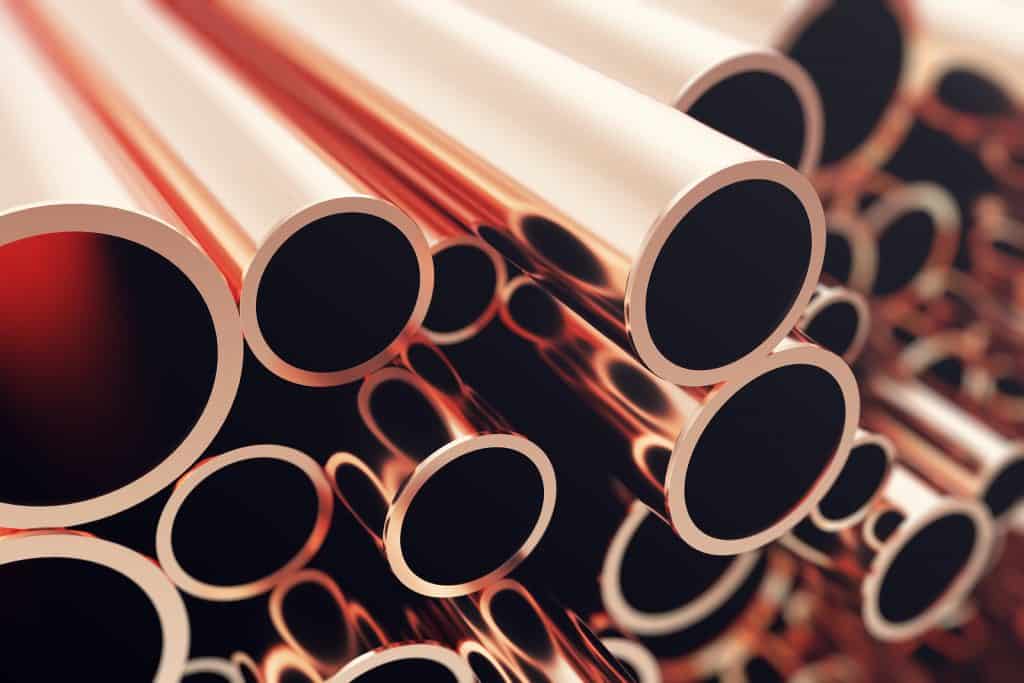
Pipes are utilized to transport hot and cold water, gas, and other forms of liquids from one place to another. The circumstances of transport decide which type of pipes must be used to carry out the transfer. How are the types of pipes selected? The work to be carried out and its suitability are the deciding factors in the selection of pipes. Also, the cost of the different types of pipes is yet another important deciding factor. For water supply and plumbing, these are the most common and different types of pipes used:
- Vitrified Clay Pipe
- Concrete Pipe
- Plastic Pipe
- Asbestos Cement Pipe
- Copper Pipe
- Steel Pipe
- Wrought Iron Pipe
- G.I. Pipe
- Cast Iron Pipe
Let’s Now Go In-Depth & Learn About Different Types of Pipes
Let’s check out in detail how many types of pipes are there and what makes these pipes different from each other.
1. Vitrified Clay Pipe
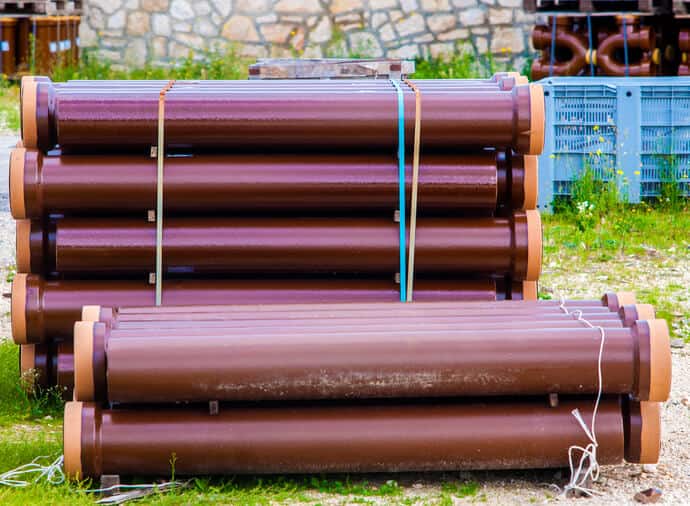
Vitrified clay pipes are not used as pressure pipes but are widely used in drainage and sewage for assisting in the flow at a partial depth.
- Vitrified clay pipes are virtually corrosion-free, have a smooth surface that provides enough hydraulic efficiency, and are long-lasting.
- It has a low tensile strength which is why it is not used under pressure and also it is difficult to secure its watertight joints.
- The most common advantage of vitrified clay pipes is the bell-and-spigot flexible compression joint. Precision mated surfaces are in tight contact with each other at these joints.
- Rubber sleeve couplings hold the corrosion-resistant steel bands together with a plain-end clay pipe. Very often the joints of these types of pipes are left open to allow water passage either in or out of the pipe.
2. Concrete Pipe
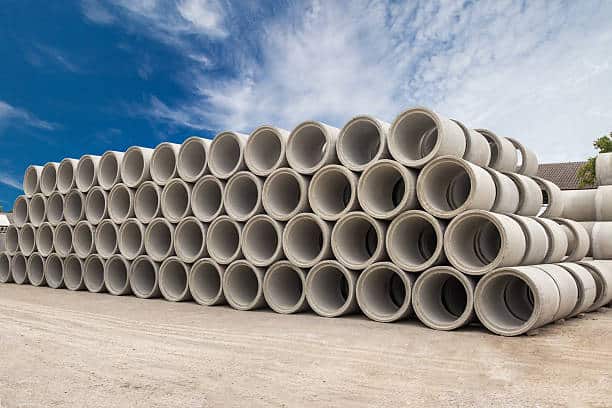
Concrete pipes are precast and are available in sizes up to 72 inches in diameter. In special order, you can get sizes up to 180 inches. Concrete pipes are the most generally used type of pipes as they can be used in high as well as low temperatures. For low temperatures, plain concrete pipes are made while for high temperatures RCC (reinforced cement concrete) is used.
- Precast concrete pipes are reinforced for sizes above 25 inches in diameter. The reinforcements could be of elliptical or spirally wound wire. In large concrete pipes, these reinforcements usually consist of 2 cylindrical cages.
- These pipes are made by rapidly rotating the form about the axis of the pipe. The centrifugal force will press the mortar tightly against the form and result in a block of high-density watertight concrete.
- Low head concrete pipes are usually joined by a mortar caulked spigot-and-bell joint. For high pressure, either a lock joint or another special joint is needed.
- For heads that are above 100 feet in height, a welded steel cylinder is often cast in the pipe to achieve water tightness.
- Precast concrete pipes are high quality because of their controlled manufacturing.
- Because of the gravity flow and the need to move forms and plants over long distances, a cast-in-place pipe can be replaced by no-joint concrete pipes. This pipe has sizes from 24 inches to 72 inches and a special pipe-laying machine with a slip form.
- Concrete pipes last around 35 to 50 years under average conditions but alkaline water will deteriorate its condition. However, If wastewater passes through concrete pipes, there might be sulfide corrosion.
- Plain concrete pipes can bear a water head of about 50 feet (15 meters) while the RCC pipes can bear a water head of about 230 feet (73 meters). If you require concrete pipes to handle even more pressure, then prestressed concrete pipes are the best.
Typically, concrete pipes require very little maintenance as these are not affected by rust, making them cost-effective. However, concrete pipes are generally very heavy so transporting them will be a task. Their repair is also very difficult.
3. Plastic Pipe
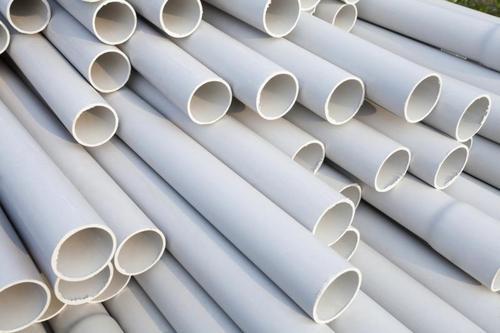
Plastic pipes are technically called PVC and rubber pipes and are used to supply alkaline water, acidic water as well as normal water; except for hot water.
- These pipes can be joined together by either a socket or a thread joint and of course, it does not catch rust.
- Plastic makes these pipes extremely lightweight and can be easily cut, bent, and joined.
- Plastic pipes are highly resistant to electric current but become useless at high temperatures. Any tampering with nails will also damage the pipes permanently.
4. Asbestos Cement Pipes
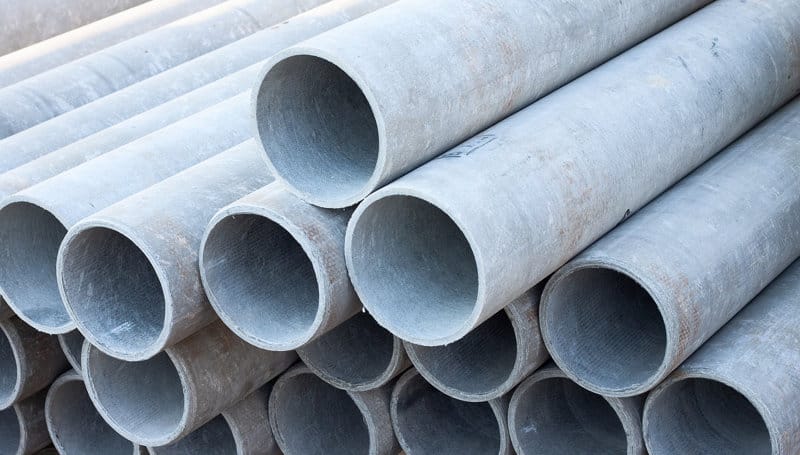
Asbestos cement pipes are made from cement, silica, and asbestos that are converted to a dense, homogenous material under pressure. It possesses considerable strength as the asbestos fiber thoroughly mixed with cement acts as reinforcement material. These pipes are used to carry water under very low pressure.
- Asbestos cement pipes are available in 4 inches to 46 inches in diameter and are 13 feet long.
- These types of pipes are made from different kinds of grades, the strongest of them being able to handle pressures up to 200 psi!
- Asbestos pipes are assembled by coupling with the help of two rubber rings and pipe sleeves. These rubber rings are compressed between the interior of the sleeve and the pipe.
- These are also extremely flexible enough to allow a 12-degree deflection while laying the pipe around curves.
- An asbestos cement pipe is extremely lightweight and can be assembled without any skilled labor. It can be joined with cast iron pipes with sulfur or lead-based compounds.
- These types of pipes can also be easily cut, threaded, and tapped for service connections. They also have high hydraulic efficiency.
- The rubber joint seals may break if exposed to petroleum products or gasoline. These pipes are also damaged easily by excavation tools and can bend easily.
- Asbestos pipes are very soft from the inside which is why their performance is better than most pipes. They do not rust and come cheap.
5. Copper Pipe
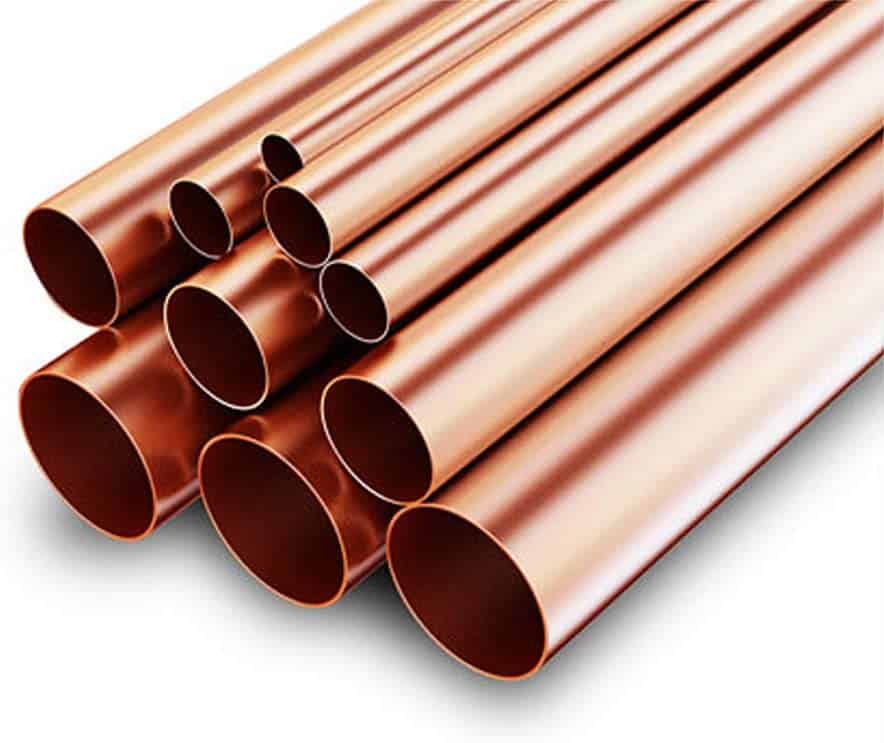
Copper pipes are generally used in carrying steam or hot water as they do not bend or sag at high temperatures.
- Copper pipes are made of small diameters and do not rust, making them highly durable. But it comes at a high cost making it rarely usable.
- Copper is a mild metal which means it can be bent easily and joined by union joints or flanged joints.
6. Steel Pipe
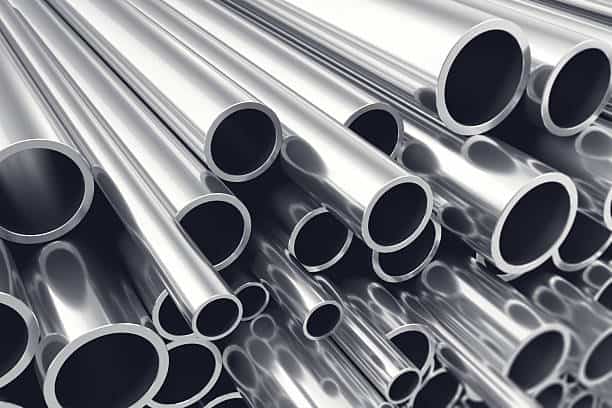
Steel pipes have the same purpose as the other types of pipes but the transportation occurs under pressure.
- These types of pipes are extremely lightweight, made from steel sheets, and have welded joints along their invisible lengths. Large steel pipes have welded or riveted joints.
- Steel pipes are galvanized, i.e., they are dipped into zinc solution to prevent it from rusting.
- The average lifespan of steel pipes is 25 to 50 years.
- These types of pipes are joined by either a welded joint or a flanged joint and can be easily bent.
- However, alkaline or acidic water will cause rust on these pipes and its repair is difficult. Steel pipes also suffer from external pressure as their walls are not appropriately thick.
7. Wrought Iron Pipe
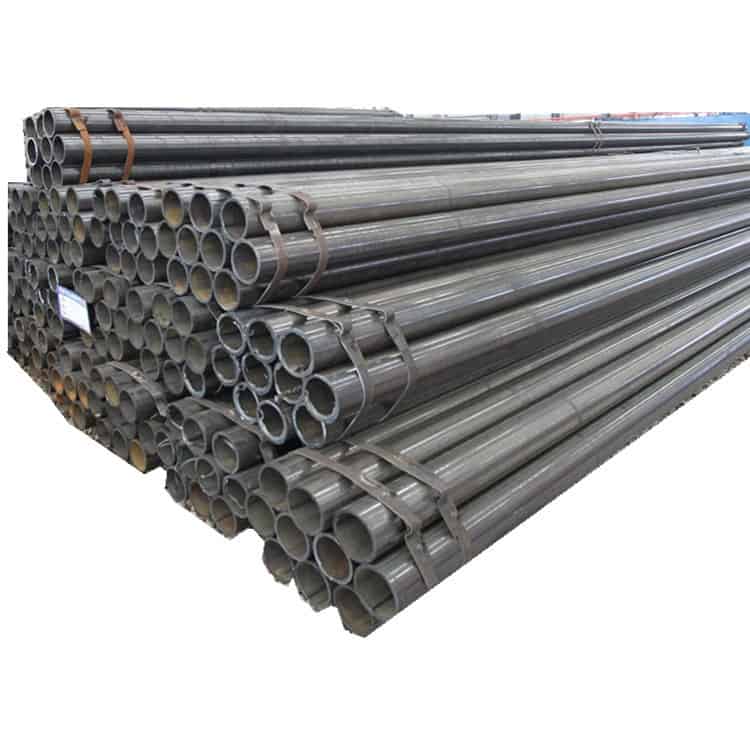
Wrought iron pipes and G.I pipes are similar, the only difference is that wrought iron pipes are made by welding wrought iron sheets.
- These pipes are used to carry liquids, water, or gas from one place to another.
- It is lightweight and easy to cut, thread, and bend.
- The diameters of wrought iron pipes are 12 mm to 15 cm, i.e. 0.5 inches to 6 inches.
Certain joints like welded, socket, and flanged joints are used to join wrought iron pipes.
8. G.I. Pipe
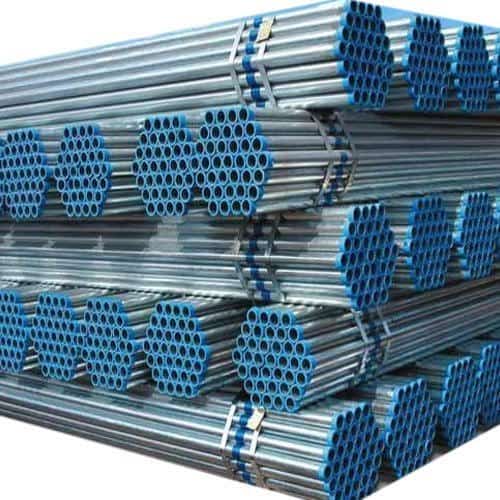
Galvanized Iron pipes are made of mild steel sheets and are used to supply gas, water, or other liquids inside a building. Also, the lengthwise joint of G.I. the pipe is welded seam type.
- I. pipes are made from 12 to 15 mm diameter, i.e., 0.5 to 6 inches, and are available in 20 feet i.e., 6 meters in length.
- The thickness of G.I. pipes differs according to their diameters.
- The pipe is dipped in zinc solution after it is constructed. This action is called galvanizing and this is the way the G.I. pipes are saved from rusting.
- The average lifetime of a G.I. pipe is 10 years and these pipes are easy to join, cut, thread, and bend. Sockets are used to join these pipes together.
- Galvanized iron pipes are cheap and lightweight but alkaline and acidic waters will damage these pipes beyond repair.
9. Cast Iron Pipe
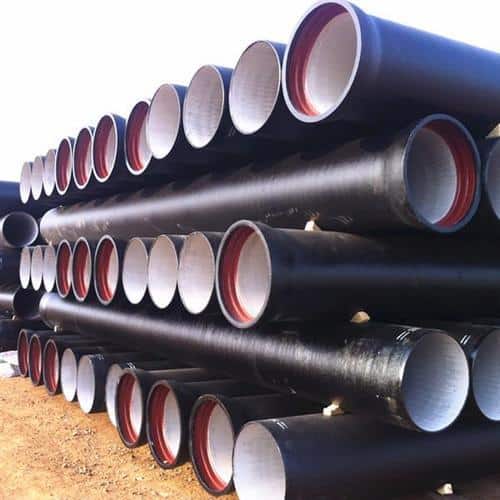
Cast iron pipes are used to construct water distribution systems because of their highly resistive nature towards corrosion. This property makes sure it lives a long life which is around 100 years under normal circumstances.
- These pipes are made of pig iron, the crude iron that is obtained in the form of oblong blocks from a smelting iron. Cast iron pipes are made from 5 to 120 cm in diameter pig iron.
- The usual length of a cast iron pipe is about 12 feet but lengths up to 20 feet can also be made. The thickness of these pipes depends upon various pressures but the maximum is 350 psi.
- Cast iron pipes are dipped in a bituminous compound to protect them from corrosion and also to improve their hydraulic properties. Large cast-iron pipes are provided with a lining of cement mortar.
- The common joints for cast iron pipes are spigot and bell joints. The spigot is wrapped around in a few strands of jute and inserted into the bell. More jute is then packed into the joint. At last, the extra space formed between the spigot and the bell is tightly caulked with the molten lead after it has cooled down.
- Neat cement mortar, patented compounds of sulfur, some other materials are used for the joints. These come cheaper than lead.
- Cast iron pipes are usually economical and cheap and can be easily joined, cut, and bored into. They are usually cut with a chisel and a hammer but for better cuts, you could use a hacksaw or a cutting cutter.
- The maximum pressure that they can bear is 7kg/cm square.
There are three methods to join a cast iron pipe:
- Expansion joint
- Hanged joint
- Spigot and bell joint
The Bottom Line
Pipes are used to carry water, gas, or any other liquid from one area to another without any leakage. Different types of pipes are used for different types of transportation such as plastic pipes or concrete pipes are used for drainage or underground sewerage. Hope you learned a few different types of pipes from this page.
Types Of Pipes FAQs:
1. What are the 4 most common types of pipes?
Here are the four most common types of pipes:
- PEX
- PVC
- Copper pipes
- Galvanized steel pipes
2. Which is the best pipe?
Copper pipes are the best for plumbing use as they are extremely reliable and durable. They are also corrosion resistant and can be used for both cold and hot water.
3. Is PVC or copper pipe better?
PVC pipes are resistant to corrosion, impact damages, and abrasion better than copper pipes because plastics don’t corrode. Also, PVC pipes are thicker than copper pipes which means fewer abrasions and damage. PVC pipes are less noisy than copper pipes even with high speed and water velocities.









